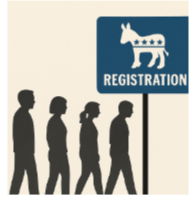Republicans are gaining ground as Democratic sign-ups stall, reshaping the electorate well before ballots are cast.
What to Know
- Democrats have lost more than two million registered voters since 2020 in key states, while Republicans have added nearly the same number.
- The sharpest erosion is in battlegrounds like North Carolina and Pennsylvania, where Democratic advantages have nearly disappeared.
- Young voters, once the party’s biggest registration engine, are signing up at much lower rates in 2024 and 2025.
- Democrats are divided, with some blaming reliance on media moments and others pointing to fragmented messaging.
- The imbalance could tilt the playing field for the 2026 midterms and set the stage for 2028.
The New York Times analysis of state voter rolls shows that Democrats are heading into the next election cycle facing a registration crisis that cannot be solved with speeches, ad campaigns, or social media pushes. Since 2020, Democrats have lost more than two million registered voters across competitive states, while Republicans have gained nearly the same amount.

Image by DALL-E
These shifts are sharpest in the battlegrounds that decide national outcomes, including North Carolina, Georgia, Arizona, and Pennsylvania. What is emerging is not a temporary setback but a structural warning sign that points to a narrowing Democratic coalition at the very moment Republicans are building steady growth from the ground up.
Why Registration Matters
Voter registration is more than an administrative process. It is the foundation of electoral power. Registration determines who can be reached, mobilized, and ultimately persuaded when campaign season begins. In states where elections are decided by razor-thin margins, even small shifts in registration can change outcomes long before Election Day.

Screenshot from The New York Times
New registrants matter even more because they often harden into reliable partisan voters over time. The fact that Republicans are steadily expanding their base means that the shape of the electorate itself is becoming more favorable to them. That advantage will not simply vanish in the next cycle. It becomes baked into the political environment, making every future campaign more difficult for Democrats to win.
The Democratic Slowdown
The Times found that Democratic registration has slowed to its weakest pace in years, with the steepest drop among younger voters. This is especially alarming because young people have historically been the party’s most reliable source of new growth.

Image by DALL-E
When younger voters fail to register in sufficient numbers, Democrats cannot offset the GOP’s consistent advantage with older voters, who both lean more conservative and turn out at higher rates. Party strategists remain divided on the causes of the slowdown. Some argue that Democrats invested too heavily in national media moments, advertising blitzes, and symbolic surrogates while allowing traditional field operations to atrophy.

Screenshot from The New York Times
Others say the deeper problem is that Democrats are speaking to voters in fragments rather than through a unified narrative. Abortion, student debt relief, and climate action energize parts of the base, but together they fail to cohere into a clear, consistent message that inspires new supporters to take the concrete step of registering to vote.
The net result is that many people who agree with Democrats on key issues never become part of the party’s voter file, leaving Republicans free to dominate the margins that decide elections.
How Republicans Are Gaining an Edge
Republicans are not expanding their coalition by accident. They are prioritizing a patient, local strategy that builds political loyalty from the ground up. Church networks, gun rights organizations, and neighborhood advocacy groups have become reliable pipelines for new registrations, embedding Republican politics into everyday community life.

Screenshot from The New York Times
These efforts do more than produce fresh registrants. They also reinforce long-term loyalty by making politics a familiar and routine part of local institutions. The Times notes that the GOP is also making notable gains among groups that Democrats once assumed would remain on their side. Latino men across the Sun Belt and younger white working-class voters in the Midwest are registering Republican in higher numbers, reshaping the coalition in ways that could be durable.
By investing in consistent grassroots infrastructure rather than depending on last-minute advertising blitzes, Republicans are steadily altering the political map in swing states. Democrats, who once relied on high turnout surges to win late, now face an opponent that is building structural advantages that will endure beyond one cycle.
What It Means for Voters
For ordinary voters, the registration imbalance is not an abstract statistic. It directly affects who will hold power in Congress after the 2026 midterms and who will shape the presidential map in 2028. When Democrats fail to keep pace in registration, they lose influence in suburban districts, state legislatures, and Senate contests where a few thousand votes can tip the balance.
The registration gap does not just weaken the party in national contests. It trickles down into local and state-level politics, eroding Democratic influence across the entire political system.

Image by DALL-E
Republicans, however, face their own test. Expanding the rolls is one step, but maintaining a diverse coalition is another. Gains among younger, more working-class, and Latino voters can shift quickly if the party pursues policies that alienate them.
Aggressive pushes on abortion restrictions or entitlement reforms could fracture Republican unity and alienate the suburban moderates who often decide close elections. The challenge for Republicans is not simply to capitalize on their registration advantage but to hold it together with a policy agenda that does not drive away the very voters who created it.
Wrap Up
The Democratic voter registration crisis is not merely a temporary weakness. It is a structural warning sign for the party’s future. Without a disciplined revival of neighborhood-level organizing, Democrats could find their coalition shrinking at precisely the moment they need to expand.
Republicans are demonstrating that slow, steady, community-driven outreach can quietly redraw the political map. If Democrats continue to rely on national messages and fragmented issue appeals, the registration imbalance of 2025 may harden into a Republican-leaning electorate that shapes American politics for years to come.




.jpg)
